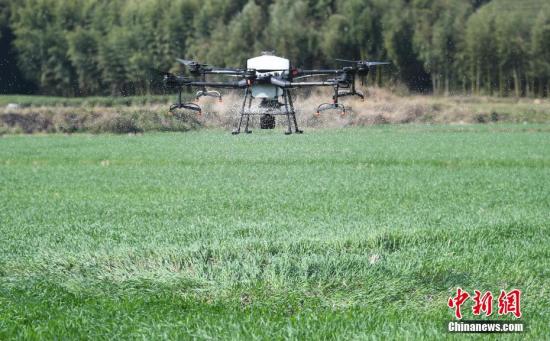China News Network, March 19th. According to the website of the Ministry of Agriculture and Rural Affairs, on March 19, Minister of Agriculture and Rural Affairs Han Changfu presided over an executive meeting of the Ministry to study the work related to the prevention and control of the new crown pneumonia epidemic and the agricultural and rural economic operations. The meeting called for further speeding up the "last mile" of agricultural resources to the field, guiding rural areas to comprehensively resume spring ploughing production, implementing various pest and disease prevention measures, and achieving a disaster-resistant and bumper harvest.
On March 5, a drone spreads fertilizer in a wheat field. Photo by China News Agency reporter Wang Gang
The meeting emphasized that we must accurately grasp the phased changes in epidemic prevention and control and the economic situation at home and abroad, adjust the focus of agricultural and rural work and response measures according to the times, adhere to the "two-handed, two-wrong", and pay close attention to spring agricultural production. Promote key work in the areas of “three rural issues” and make up for shortcomings, and provide strong support for decisive victory in building a well-off society in an all-round way and for fighting poverty.
The meeting pointed out that it is necessary to scientifically judge the current epidemic prevention and control and economic situation, and put forward clear requirements for the prevention and control of the epidemic situation, promotion of resumption of work and production, and restoration of normal production and living order. All departments, bureaus, and units must conscientiously carry out the implementation and accelerate the implementation of key tasks.
The meeting emphasized that since the outbreak, the Ministry of Agriculture and Rural Affairs has actively responded to the impact of the epidemic, coordinated and resolved difficult problems faced by agricultural production, and actively cooperated with the prevention and control of rural epidemic situations, and achieved significant results in stages. Spring ploughing has been fully launched, and the “vegetable basket” products have achieved steady production, guaranteed supply, and solid progress. Agricultural enterprises have accelerated their resumption of work, and the agricultural and rural economy is generally stable. In the next step, we must adhere to the problem-oriented approach and fully implement the various tasks of spring agricultural production.
The first is to do a good job of spring planting in small springs, compacting and tightening the governor's responsibility system for food security, doing everything possible to put in place the intended planting area, further accelerating the "last mile" of agricultural resources to the field, and guiding rural areas to fully resume spring cultivation. Implement various pest control measures to achieve a bumper harvest against disasters.
The second is to speed up the restoration of pig production, conscientiously implement the provincial general responsibility requirements and the "vegetable basket" mayor responsibility system, guide localities to implement the task objectives in place, and "grasp the big and bring the small" to drive small and medium-sized farmers to supplement their pens. At the same time, we must continue to do a good job in monitoring and controlling African swine fever, strengthen scheduling, respond quickly, and deal with new epidemics in a timely manner.
The third is to continue to do a good job of "vegetable basket" products to stabilize production and supply. In response to the likely recovery of consumption growth after the epidemic, plan ahead to respond to ensure the supply of meat, eggs, fish, vegetables and other products.
The fourth is to work hard to promote the increase of farmers' employment income, actively cooperate with relevant departments to organize migrant workers to return to work as soon as possible and return to work, step up industrial poverty alleviation and employment assistance, increase rural policy support for entrepreneurship and innovation, and expand employment opportunities in rural areas.

